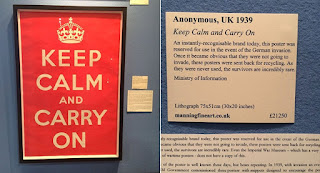Keep Calm and Carry On was a motivational poster produced by the British government in 1939 in preparation for the Second World War. It was encouragement for the British to keep their "stiff upper lip" in light of what was coming. In 2000, Stuart Manley, co-owner with his wife Mary of Barter Books Ltd. in Alnwick, Northumberland, was sorting through a box of used books bought at auction when he uncovered one of the original "Keep Calm and Carry On" posters. The couple framed it and hung it up by the cash register; it attracted so much interest that Manley began to produce and sell copies. Other companies followed suit, and the design rapidly began to be used as the theme for a wide range of products. Mary Manley later commented, "I didn't want it trivialised; but of course now it's been trivialised beyond belief."
As the popularity of the poster in various media has grown, innumerable parodies, imitations and co-optations have also appeared, making it a notable meme. Messages range from the cute to the overtly political, typically with references to other aspects of popular culture. (source)






Comments
Post a Comment